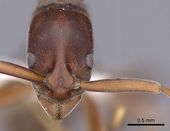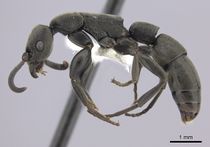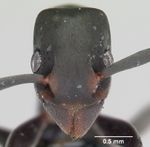Key to New World Platythyrea
This worker key is based on: De Andrade, M. L. 2004. A new species of Platythyrea from Dominican amber and description of a new extant species from Honduras (Hymenoptera: Formicidae). Revue Suisse de Zoologie. 111(3):643-655. (page 644, worker described)
The following identification key to the worker of Platythyrea from the New World, including all known extant and fossil species, is based on Brown's (1975) key for this genus modified to include the species described afterward by Kugler (1977), Lattke (2003) and De Andrade (2004, this study). Platythyrea dentata, known from the gyne only (see next paragraph). Longino (2003), in a web document, state that the mandibular sulcus, used by Brown (1975) to differentiate Platythyrea sinuata from Platythyrea pilosula, shows a high degree of variation in most Costa Rican sinuara and, as a consequence of this, treats sinuara as a junior synonym of pilosula. This proposal is accepted in the key below, even if the source cannot be considered a publication for nomenclatorial purpose.
The original description of Platythyrea dentata, known from a sole gyne from Dominican amber, gives HW 0.87 mm (eyes excluded). According to Lattke’s drawing the HW of this specimen (eyes included), to render it comparable with the figures given by Brown (1975) should be about 0.93 mm. By using the key to the workers above, the gyne of P. dentata falls to couplet 2 (mandibles with teeth) where it can be easily differentiated from both other two species, prizo and lenca, by the hind coxae dorsally dentate and by the anterior clypeal margin straight instead of convex.
You may also be interested in
1
- HW (eyes included)> 0.90 mm . . . . . 2
- HW (eyes included) < 0.90 mm . . . . . 7
2
return to couplet #1
- Mandibles with teeth . . . . . 3
- Mandibles without teeth . . . . . 4
3
return to couplet #2
- Erect hairs on petiole, postpetiole and gaster sparser and shorter. EL ≥ 0.30 mm . . . . . Platythyrea prizo
- Erect hair on petiole, postpetiole and gaster denser and longer. EL = 0.25 mm . . . . . Platythyrea lenca
4
return to couplet #2
- HW (eyes included) > 1.4 mm. EL > 0.45 mm. Fore basitari with 3 setae opposite to the strigil . . . . . Platythyrea strenua
- HW (eyes included) < 1.4 mm. EL < 0.45 mm. Fore basitarsi with 1 or 2 setae opposite to the strigil . . . . . 5
5
return to couplet #4
- Profemur strongly swollen (W/L > 0.38) . . . . . Platythyrea angusta
- Profemur less tick (W/L < 0.38) . . . . . 6
6
return to couplet #5
- Petiolar node > 0.85 mm long. Petiole about 1/4 longer than broad. Fore basitarsi with 2 setae opposite to the strigil . . . . . Platythyrea pilosula (= sinuata)
- Petiolar node < 0.85 mm long. Petiole about as long as broad or slightly longer than broad. Fore basitarsi with 1 seta opposite to the strigil . . . . . Platythyrea punctata
7
return to couplet #1
- Metacoxal dorsum with a tooth. Posterior margin of petiolar node as seen from above with lateral corners produced caudad as short, blunt teeth or angles. Clypeus dorsally swollen . . . . . Platythyrea exigua
- Metacoxal dorsum unarmed. Posterior margin of petiolar node with at most weakly armed lateral corners. Clypeus dorsally flat . . . . . 8
8
return to couplet #7
- Scapes reaching the vertexal margin. TL = 5.9 mm. SI > 70 . . . . . Platythyrea procera
- Scapes much shorter, not reaching the vertexal border. TL < 5.0 mm. Sl < 60 . . . . . 9
9
return to couplet #8
- Head elongate, about 1/3 longer than broad. CI < 63 . . . . . Platythyrea pumilio
- Head shorter, about 1/7 longer than broad. CI > 80 . . . . . 10
10
return to couplet #9
- Petiolar node elongate (W/L 0.67). Profemur swollen (W/L 0.47). TL < 4.0 mm . . . . . Platythyrea scalpra
- Petiolar node shorter (W/L 0.86). Profemur less thick (W/L 0.41). TL > 4.8 mm . . . . . Platythyrea zodion













